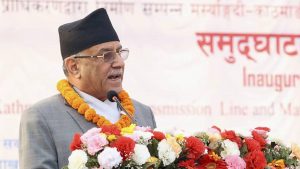
More than 2,000 Nepalis Leaving for Foreign Employment Daily

Recent data released by the Department of Foreign Employment (DoFE) has revealed a staggering trend as more than 2,000 Nepalis are leaving for foreign job destinations every day, sparking concerns among experts about the implications of such high rates of migration.
In the Nepali month of Magh (mid-January to mid-February), 62,147 individuals received labor approval and re-entry approval, marking a slight decrease of 666 compared to the previous month of Poush (mid-December to mid-January) when 65,813 Nepalis embarked on overseas employment opportunities. Throughout the fiscal year, significant numbers have been leaving for foreign employment, with figures ranging from 43,622 to 56,235 in recent months, underscoring the persistent trend of Nepali laborers seeking opportunities abroad.
In the first seven months of the fiscal year 2023/24, a total of 405,552 Nepalis ventured overseas for job prospects, indicating a decline of 43,278 compared to the same period in the previous fiscal year. Despite this decrease, concerns persist over the sheer volume of daily departures.
Remarkably, over 54,000 Nepali women were part of this migration wave during the review period, seeking job opportunities across 71 countries. The United Arab Emirates (UAE), Japan, Israel, and Cyprus were highlighted as popular destinations for Nepali migrant workers.
Foreign employment expert, Purna Chandra Bhattarai, expressed concern over the unprecedented departure rate, emphasizing the need for a deeper understanding of the implications beyond remittance inflows. Bhattarai pointed out that Malaysia and three Gulf countries remain the primary destinations for Nepali workers, urging the government to adopt a comprehensive approach towards foreign employment.
“The departure of nearly 2,300 Nepalis daily for foreign employment is not normal. The number excludes those leaving the country for higher education. This can invite severe problems for the country,” remarked Bhattarai, underscoring the potential socio-economic challenges associated with such high rates of migration.
Echoing Bhattarai’s sentiments, concerns were raised about the sustainability of relying solely on remittances, with calls for diversification of the economy and creation of more domestic job opportunities.
According to the Nepal Rastra Bank (NRB), remittances to Nepal amounted to Rs 733.22 billion in the first seven months of the current fiscal year, reflecting the significant role foreign employment plays in the country’s economy.
As the trend of Nepali labor migration continues, stakeholders are increasingly called upon to address the multifaceted challenges and opportunities associated with foreign employment, ensuring sustainable development and the well-being of migrant workers and their families.














Comments